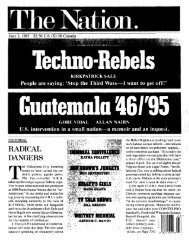Divergent Trajectories: Healthcare Insurance Reforms in East Asia ...
Divergent Trajectories: Healthcare Insurance Reforms in East Asia ...
Divergent Trajectories: Healthcare Insurance Reforms in East Asia ...
You also want an ePaper? Increase the reach of your titles
YUMPU automatically turns print PDFs into web optimized ePapers that Google loves.
Illan Nam, Colgate University, Feb 2011Draft <strong>in</strong> progress, please do not quote or citega<strong>in</strong> by the proposed reform. The design of a program highlights these tradeoffs muchmore emphatically than its overall estimated cost.Power resources theoryThe central dynamic that animates the power resources theory is the conflictbetween workers and capitalists, two pr<strong>in</strong>cipal social groups <strong>in</strong> a capitalist democracythat have access to different resources. Capitalists wield market-based resources that putthem at considerable advantage aga<strong>in</strong>st workers. To mitigate their vulnerability to themarket economy, workers need to rely on their strength of numbers and formorganizations that articulate their <strong>in</strong>terests. Importantly, these work<strong>in</strong>g class demands aremediated by left parties <strong>in</strong> the political arena. 26Accord<strong>in</strong>g to power resources theory,variations <strong>in</strong> the size and shape of welfare regimes are produced by the relativedifferences between resources mobilized by the work<strong>in</strong>g class and left parties and thestrength of the organization of the capitalists and right parties (Castles, Esp<strong>in</strong>g-Anderson,Korpi, Huber and Stephens).An <strong>in</strong>fluential <strong>in</strong>sight underp<strong>in</strong>n<strong>in</strong>g power resources theory is the recognition thatorganized power of the subord<strong>in</strong>ate classes can counterweigh the power of capital; thus,this school emphasizes that relative power organizations are critical to exercis<strong>in</strong>g voice <strong>in</strong>the political arena. In their absence, workers lack tools to be effective actors and <strong>in</strong>steadsubside <strong>in</strong>to a passive group that is “acted upon.” However, notwithstand<strong>in</strong>g theresonance of this <strong>in</strong>sight, it is unclear, given the weakness of labor organizations <strong>in</strong>develop<strong>in</strong>g democracies, whether plac<strong>in</strong>g so much explanatory weight on a relativelyattenuated actor illum<strong>in</strong>ates the outcomes. While labor organizations dim<strong>in</strong>ished <strong>in</strong>26 Evelyn Huber and John D. Stephens, Development and Crisis of the Welfare State: Parties and Policies<strong>in</strong> Global Markets (Chicago: The University of Chicago Press, 2001)20













